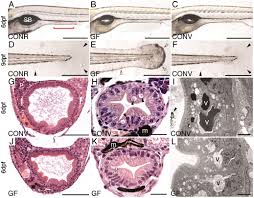Methods for Generating and Colonizing Gnotobiotic Zebrafish
7/24/2014
Pham LN, Kanther M, Semova I, Rawls JF. Nat Protoc. 2008;3(12):1862-75. doi: 10.1038/nprot.2008.186.
Vertebrates are colonized at birth by complex and dynamic communities of microorganisms that can contribute significantly to host health and disease. The ability to raise animals in the absence of microorganisms has been a powerful tool for elucidating the relationships between animal hosts and their microbial residents. The optical transparency of the developing zebrafish and relative ease of generating germ-free zebrafish makes it an attractive model organism for gnotobiotic research. Here we provide a protocol for: generating zebrafish embryos; deriving and rearing germ-free zebrafish; and colonizing zebrafish with microorganisms. Using these methods, we typically obtain 80–90% sterility rates in our germ-free derivations with 90% survival in germ-free animals and 50–90% survival in colonized animals through larval stages. Obtaining embryos for derivation requires approximately 1–2 hours with a 3–8 hour incubation period prior to derivation. Derivation of germ-free animals takes 1–1.5 hours, and daily maintenance requires 1–2 hours.

 Gastrointestinal System
Gastrointestinal System




